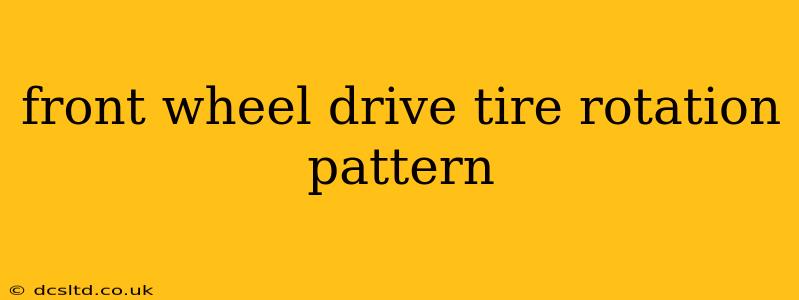Front-wheel-drive (FWD) vehicles require a specific tire rotation pattern to ensure even tire wear and maximize lifespan. Ignoring this can lead to uneven tread wear, reduced fuel efficiency, and compromised handling. This guide will cover the recommended rotation patterns, explain why they're crucial, and answer some frequently asked questions.
Why Rotate Your Tires?
Tire rotation is a vital part of car maintenance, regardless of whether you drive an FWD, rear-wheel-drive (RWD), or all-wheel-drive (AWD) vehicle. Uneven tire wear is a common problem, particularly on FWD cars which experience more stress on the front tires due to the engine's location and the drive force. Rotating your tires helps to:
- Extend Tire Lifespan: By distributing wear more evenly across all four tires, you significantly increase their lifespan.
- Improve Fuel Efficiency: Properly inflated and balanced tires, rotated regularly, contribute to better fuel economy.
- Enhance Handling and Safety: Consistent tread depth across all tires improves traction, braking, and overall vehicle handling.
Common Front Wheel Drive Tire Rotation Patterns
There are two primary tire rotation patterns used for FWD vehicles:
1. The "X" Pattern: This is the most common and generally recommended method. Follow these steps:
- Front Right Tire: Moves to the Rear Left Tire position.
- Front Left Tire: Moves to the Rear Right Tire position.
- Rear Left Tire: Moves to the Front Right Tire position.
- Rear Right Tire: Moves to the Front Left Tire position.
This pattern effectively crosses the tires from front to back diagonally, ensuring even wear. Think of it as drawing an "X" across your tires.
2. The "Forward" Pattern: This pattern is a simpler alternative but may not be as effective at equalizing wear, especially if you already have noticeable uneven wear.
- Front Right Tire: Moves to the Rear Right Tire position.
- Front Left Tire: Moves to the Rear Left Tire position.
- Rear Right Tire: Moves to the Front Right Tire position.
- Rear Left Tire: Moves to the Front Left Tire position.
This method moves tires forward or backward along the same side. It's less effective at addressing uneven wear but is simpler to visualize.
Which Pattern Should You Use?
Generally, the "X" pattern is preferred for its superior effectiveness in evening out wear. However, consult your owner's manual as some manufacturers may recommend a specific pattern for your vehicle model. If you notice significant uneven wear on your tires (such as severe cupping or feathering), it’s best to consult a tire professional for advice.
How Often Should I Rotate My Tires?
The recommended tire rotation interval is usually every 5,000 to 8,000 miles, or every 6 months, whichever comes first. However, always check your owner's manual, as this can vary depending on your vehicle and driving conditions. More frequent rotations may be necessary if you experience aggressive driving habits or frequently haul heavy loads.
What About Spare Tires?
Spare tires, especially temporary "donut" spares, should generally not be included in the rotation. These are designed for temporary use only and may not have the same tread depth, construction, or performance characteristics as your regular tires.
Can I Rotate My Tires Myself?
While you can rotate your tires yourself, it's crucial to have the correct tools and understand the process. If you're unsure, it's best to have a qualified mechanic or tire professional perform the rotation. Improper rotation can lead to further tire damage.
What if My Tires Have Directional or Asymmetrical Tread Patterns?
Some tires have directional or asymmetrical tread patterns. These tires have arrows or specific markings indicating the correct rotation direction. When dealing with these types of tires, rotation options are more limited. Consult your tire manual or a tire professional for guidance. Often, only the front-to-front and rear-to-rear rotation within the same side is possible in these cases.
By following these guidelines and regularly rotating your tires, you'll ensure that your tires wear evenly, which translates to improved safety, handling, fuel economy, and a longer tire lifespan. Remember to always consult your owner's manual for the specific recommendations for your vehicle model.
